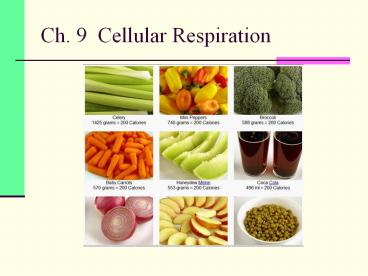Ch. 9 Cellular Respiration - PowerPoint PPT Presentation
1 / 26
Title:
Ch. 9 Cellular Respiration
Description:
Ch. 9 Cellular Respiration Harvesting chemical energy Living is lots of work Polymerization, Growth, highly organized, and movement all require energy Energy enters ... – PowerPoint PPT presentation
Number of Views:114
Avg rating:3.0/5.0
Title: Ch. 9 Cellular Respiration
1
Ch. 9 Cellular Respiration
2
Harvesting chemical energy
- Living is lots of work
- Polymerization, Growth, highly organized, and
movement all require energy - Energy enters Earths ecosystems as sunlight
- Harvesting of energy requires a series of
metabolic steps - AEROBIC CELLULAR RESPIRATION
- Glycolysis
- Krebs cycle
- Electron transport chain
3
Organic compounds
- Energy stored in chemical bonds (position)
- Enzymes help regulate this metabolism
- Organic macromolecules are rich in potential
energy and are broken down to simpler compounds
with less energy. - Breaking of bonds allows work to be done.
- Organic oxygen ? carbon water energy
- compounds dioxide
4
(No Transcript)
5
Exergonic reaction
- Organic oxygen ? carbon water energy
- compounds dioxide
- C6H12O6 6 O2 ? 6 CO2 6 H2O energy
-
(ATP heat) - DG - 686 kcal
6
Possible pathways
- Complete, aerobic cellular respiration
- Complete oxidation of carbohydrates using
- Glycolysis
- Krebs cycle and
- Electron transport chain REQUIRES OXYGEN
- Incomplete/ partial oxidation
- Gylcolysis only
- Glycolysis Lactic acid fermentation
- Glycolysis Alcoholic fermentation
7
(No Transcript)
8
Redox reactions
- Movement of e- is what is used to store and
release energy in bonds of organic cpds. - Redox reactions oxidation-reduction reactions
transfer an e- from one reactant to another - Reduction
- Addition/receipt of e-, more negative
- Oxidation
- Loss of e- (often to O), more positive
9
(No Transcript)
10
Falling electrons
- The step wise fall of electrons from organic
compounds rich in bonds, to simpler compounds
increases the entropy of the system. - Electrons are shuttled through a series of
carriers (membrane proteins) that allows for
release of energy to be in small (usable)
increments. - Electron transport chains
11
(No Transcript)
12
Aerobic cellular respiration
- Requires oxygen ( for e- acceptor at end of ETC)
- 3 parts
- Glycolysis ( splitting of sugar molecules )
- Some substrate level phosphorylation of ATP
- Krebs cycle ( transfer of e- to NADH, FADH)
- Some substrate level phosphorylation of ATP
- ETC ( generates ATP using ETC)
- Much oxidative phosphorylation of ATP
- Occurs in eukaryotic cells need mitochondrion
(for Krebs and ETC) and oxygen supply for (ETC)
13
(No Transcript)
14
(No Transcript)
15
Glycolysis
- Glyco sugar, glucose
- Lysis to split or break
- sugar splitting
- Cytoplasm
- ALL CELLS ! Doesnt require mitochondrion
or O2 - 1 glucose 2 ATP and 2 NADH
- 2 ATP are net ( 4 generated 2 invested )
- Know steps on pgs. 168-169.green boxes
- Note color coding used in chapter green
glycolysis, salmon Krebs and purple ETC
16
(No Transcript)
17
- Summary of Steps
- Spend 1 ATP
- Add P to glucose
- 2. Glucose converted to isomer (fructose) by an
enzyme - 3. Spend 2nd ATP
- add 2nd P to fructose
- now in debt ( 2ATP)
- Molecule very unstable (primed)
18
Summary of Steps 4. 6 C sugar cleaved into 2
3C sugars They are isomers 5. An enzyme called
isomerase converts both isomers into
glyceraldehyde (PGAL) From now on all steps are X2
PGAL
19
Summary of Steps 6. Enzyme adds an inorganic
phosphate, sugar give e- and H to NAD making
NADHremember x2 7. MAKE ATP (X2) now out of
debt, organic acid 8. Relocate P ( on both
molecules)
20
Summary of Steps 9. Generates water and creates
double bond. P bond now unstable 10. P leaves
adds to ADP generates more ATP (2more) now have 2
net ATP. Glucose is now split into 2 3 C
molecules PYRUVATE 2 NADH can go to ETC and make
ATP using oxidative phosphorylation
21
Krebs Cycle aka Tricarboxylic Acid Cycle (TCA)
and Citric Acid Cycle
- Sir Hans Krebs 1900-1981, 1953 Nobel Prize, 1958
knighted - 3 C pyruvate at end of glycolysis
- Not soluble in mitochondrial membrane
- Loses C (CO2) becomes acetyl
- Creates a NADH ( stores some energy )
- Bonds to coenzyme for transport
- now Acetyl CoA
- Crosses mitochondrial membrane
- Bonds to 4C oxaloacetate to make
- 6C citrate or citric acid
- Series of steps to lose C ( makes CO2 ) and
- Store energy as NADH and FADH and ATP
- Regenerates the oxaloacetic acid. cycle
22
(No Transcript)
23
Electron Transport Chain
- Collection of molecules embedded in the inner
mitochondrial membrane - Folding increases surface area ( of reactions)
- Most compounds are proteins (some pigments)
cytochrome c used to trace DNA lineage - Function as enzymes directing the flow of
reactions that move e- (alternate between
oxidized and reduced state) - NADH and FADH2 are from Krebs and glycolysis
- NADH and FADH2 release H to these reactions
- H is split into H and e-
- The e- move through the carriers to the biggest
e- acceptor (moving down hill releasing
potential energy and increasing entropy) - The H accumulate in space btwn membranes
24
ETC continued
- As the e- get to the last acceptor they have
released all the energy they were carrying from
C-C bonds in glycolysis and Krebs - The H can not accumulate indefinitely btwn
membranes (high acidity) - H flows through protein pump called ATP synthase
toward e- and their acceptor (OXYGEN) - This creates water and also
- Is used to generated energy to add P to ADP
- ATP is generated using oxidative phosphorylation
25
(No Transcript)
26
(No Transcript)































